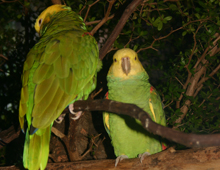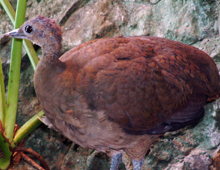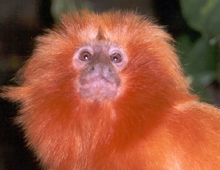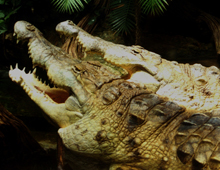Orinoco

Yellow-headed Amazon parrot, Amazona oratrix oratrix
This Mexican parrot has long been a popular pet, prized for its “talking” and “singing”. This led to trappers stealing young birds from nests wherever they could find them. In two decades, the population fell from 700,000, in the mid-1970s, to only 7,000! This decline continues, worsened by habitat destruction. However, this species breeds well in captivity, with many hatched each year. The breeding pair at the DWA have so far reared two broods of chicks in full public view.
LEARN MORE
Fiery-billed aracari, Pteroglossus frantzii
This bird has one of the smallest ranges of any toucan along the Pacific coast of Costa Rica, and a small portion of Panama. It is not rare there, but has hardly ever been seen in captivity. Through special permits from the Government of Panama, the DWA received several birds, and the world’s first captive breeding took place in Dallas in 2008.
LEARN MORE
Great tinamou, Tinamus major
Though found from Mexico to Brazil, this primitive bird has never been common in captivity. Chicks were hatched in California in the 1970s, but the species had long vanished from US collections by the time several were imported from Panama by the DWA in 2009. The large eggs are a beautiful shade of blue.
LEARN MORE
Citron-throated toucan, Ramphastos vitellinus
Always extremely rare in captivity, this subtly beautiful toucan is common in its limited range in Colombia and Venezuela. Several arrived at the DWA through the cooperation of the Venezuelan conservation organization, FUNZPA.
LEARN MORE
Golden lion tamarin, Leontopithecus rosalia
Forty years ago, this magnificent monkey appeared on its way to extinction, both in its native Atlantic Coastal Forest of Brazil and in zoos as well. The wild population fell to less than 600, and in zoos, the number of deaths exceeded births. Over the next decade, improvements were made in zoo management, so that from a low of around 75, a self-sustaining population, today numbering nearly 500 world-wide, has been established. Through the reintroduction of captive-bred animals and habitat preservation, there are more than 1,000 in the wild.
LEARN MORE
Orinoco crocodile, Crocodylus intermedius
This large species is similar to the American crocodile. The body is made up of scales (scutes) that vary in shape and strength. Orinoco crocodiles can be identified by the arrangement of dorsal (back) armor with six prominent scales on the back of the neck. Osteoderms (bony deposits within each scale) are rough in texture and are often different in color. Orinoco crocodiles have no osteoderms on their light colored belly, Another identifying feature of the Orinoco crocodile is the narrow snout which slopes upward near the tip. The nostrils are set at the end to allow breathing while mostly submerged. The tongue is wide and attached to the bottom of the mouth and does not aid in the capturing of prey. Their body color varies from gray-green, tan, to gray scattered with dark green. The legs are short and strong; the long tail is quite powerful.
LEARN MORE
Electric eel, Electrophorus electricus
Not related to saltwater or migratory eels, this South American fish has an elegantly minimal method of moving through water. This is mostly achieved by a parabolic wave generated through the long ventral fin. The tiny pectoral fins may steer. Most of the body is taken up by electricity generating tissue. An adult may produce a 500-watt charge. The digestive and reproductive organs are confined to a small area just behind the head. Exhibited at New York’s Central Park Zoo more than a century ago, it has long been a popular aquarium display.
LEARN MORE
Aquatic caecilian, Typhlonectes natans
Very few of the 180 or so caecilian species are easily exhibited in zoos or aquariums, as most live underground. This South American species is an exception, living in water instead. It has been bred in captivity, including the DWA, giving birth to live young. Confined to parts of the Old and Near World Tropics, caecilians compose one of the three orders of amphibians (the other two being frogs and toads, and salamanders). They are the only living amphibians with scales, but these are hidden beneath their skin.
LEARN MORE
Mata mata turtle, Chelus fimbriatus
A resemblance to a pile of rotting leaves serves this reptile well. When unaware small fishes swim too close, they disappear instantly — sucked in by a powerful vacuum created when it opens its jaws. Found in quiet water across a large area of tropical South America, it usually only comes onto land to lay its eggs. It rarely swims, preferring to walk underwater, taking air at the surface through the unique proboscis in front of its tiny eyes.
LEARN MORE
Yellow-spotted Amazon turtle, Podocnemis unifilis
In the 1960s, vast numbers of the tiny, brightly colored young of this species were sent to the US with shipments of tropical fish, but most did not survive. Since females may exceed 17 inches in shell length, they are not appropriate for most home aquariums. Serious private collectors and zoos have done well with them, and they have bred many times in captivity. While considered vulnerable to extinction, they remain an important resource for Native Americans in parts of their wide South American range.
LEARN MORE

